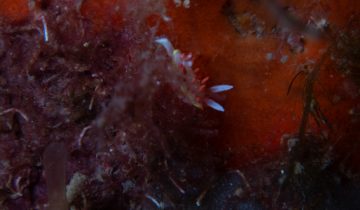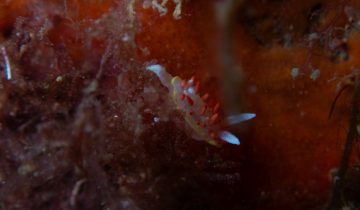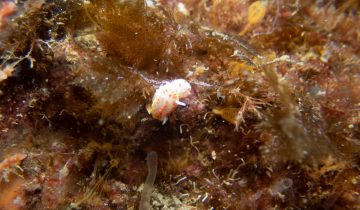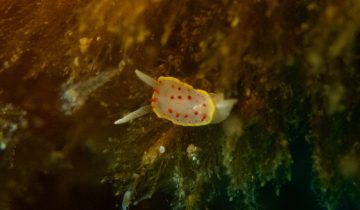Diaphorodoris papillata, commonly known as the red papillae sea slug, is a nudibranch of the family Calycidorididae, within the order Nudibranchia. Its scientific name derives from the Greek ‘diaphoros‘ (meaning different) and ‘Doris‘ (a sea nymph from Greek mythology), while ‘papillata‘, from Latin, means ‘with papillae‘, clearly referring to the digitiform protuberances that adorn its back. This species is found in temperate marine waters of the western Mediterranean, including Italy, France, and Spain, and has also been recorded in the eastern Atlantic (Portugal, Strait of Gibraltar, Canary Islands). It primarily inhabits hard bottoms, shaded vertical rocky walls, and areas rich in algae and encrusting fauna, usually at depths less than 15 meters.
The body of Diaphorodoris papillata is small, reaching a maximum length of 10 mm. It has an oval mantle, wider in the anterior region, bordered by a yellow stripe. Its most distinctive feature is the thin, elongated red dorsal papillae, which may branch at the apex or base. The body is translucent white with opaque white speckling. The rhinophores are long, partially retractable, with 12-14 lamellae, inserted in sheaths with small marginal tubercles. The gills consist of 5-6 unipinnate leaves, with the three anterior ones—especially the central—being larger. The tail is triangular and well-developed, showing an opaque white dorsal line. It closely resembles Diaphorodoris luteocincta, which differs by having well-spaced white conical tubercles and scattered red spots on the mantle instead of the red papillae characteristic of Diaphorodoris papillata.
Diaphorodoris papillata feeds primarily on encrusting bryozoans, mainly Smittina reticulata. This specialized diet makes it an important species within the benthic ecosystem, helping to control the proliferation of sessile organisms on rocky substrates. It has also been observed in Posidonia oceanica meadows and areas abundant in sponges, although bryozoans remain its main food source.
This sea slug is a simultaneous hermaphrodite, meaning each individual possesses both male and female reproductive organs. Fertilization is reciprocal, occurring through sperm exchange between two individuals via a copulatory organ located on the right side. Although observed year-round, no clear reproductive seasonality is known. There are reports of mating between Diaphorodoris papillata and Diaphorodoris alba, but such unions are thought not to produce viable offspring, as no hybrids have been observed.
A notable curiosity of Diaphorodoris papillata is its geometric and striking coloration pattern, which has made it popular among divers and underwater photographers. Its presence has been widely documented along the Costa Brava, from Cadaqués to Blanes, including the Medes Islands and Tossa de Mar. Despite its small size, its vivid coloration and complex body structure make it easily identifiable. No obligatory symbiotic or mutualistic relationships with other species are known, although its presence is closely linked to the abundance of specific bryozoans. Its appearance has occasionally led to comparisons with fantastic creatures like marine unicorns, sparking great scientific and popular interest.
Photos:




